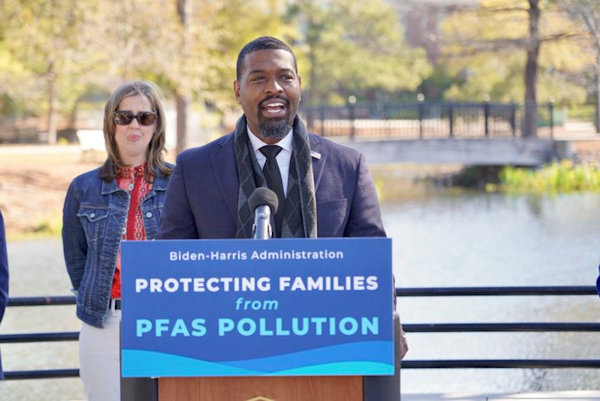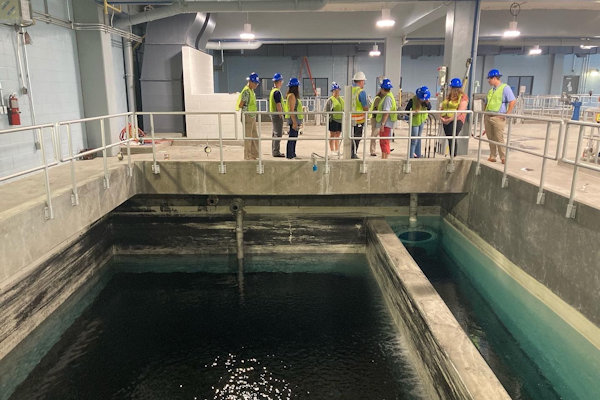SEJournal Online is the digital news magazine of the Society of Environmental Journalists. Learn more about SEJournal Online, including submission, subscription and advertising information.
 |
 |
| A federal proposal for limiting PFAS in drinking water faces a long, arduous process before enactment. Above, U.S. Environmental Protection Agency Administrator Michael Regan, announcing the proposed standard in March. Photo: @EPAMichaelRegan via Twitter. |
Issue Backgrounder: Painful Process Underway of Regulating PFAS in Drinking Water
By Joseph A. Davis
 |
The presence of PFAS “forever” chemicals in drinking water is a major environmental story in many communities. But local utilities and the U.S. Environmental Protection Agency face big challenges regulating them, with huge fallout from a process that could take years and eventually cost ratepayers billions.
Public concern over PFAS, a class of thousands of persistent chemicals used widely in industry and commercial products, has been high for years, especially in places where it has already contaminated public drinking water supplies.
They have polluted land and water, and their toxic effect on humans is better understood today than it was decades ago when they were introduced into commerce.
Depending on the specific chemical involved and the amount of human exposure, for example, PFAS can cause:
- decreased fertility and pregnancy complications
- developmental effects and babies with low birth weights
- higher risk of prostate, kidney and testicular cancers
- reduced ability of the immune system to fight infections
- increased cholesterol levels and obesity
Arduous standard-setting underway
Virtually all public drinking water systems in the United States are regulated under the Safe Drinking Water Act — which directs the EPA to set national standards and authorizes states to enforce them.
The enforceable standards are called “maximum contaminant levels,” or MCLs. The agency already sets MCLs for about 90 contaminants.
The EPA took a huge first step on PFAS
in March, proposing a new rule limiting
PFAS chemicals in drinking water.
And the EPA took a huge first step on PFAS in March, proposing a new rule limiting PFAS chemicals in drinking water. [Find the text of the EPA’s proposed rule, the regulatory docket and further information from the EPA on its proposal.]
But one relevant fact, which agency critics are quick to point out — the EPA hasn’t added any new contaminant to the MCL list since 1996.
Currently, the EPA currently posts a nonmandatory “advisory” level for key PFAS at 70 parts per trillion, or ppt. Its MCL proposal, however, would ratchet that down to 4 ppt.
That’s the lowest concentration at which they can currently be detected — and lower than many state standards. (In the absence of mandatory federal drinking water standards, some 20 states have issued standards of their own. Only a few, however, are final and mandatory.)
Meanwhile, private wells, which serve about 15% of U.S. residents, are not regulated by the federal government, nor in most cases by states.
Setting MCLs for any drinking water contaminant is an arduous (and lengthy) process. That is, it involves a long time lag between the proposed and final rule. And it includes public meetings and comment periods that capture concerns from the public, health experts and industry, among others.
In the case of PFAS, the process will likely be lengthened by the fact that EPA is regulating multiple chemicals in a class. And once the rule is finalized, lawsuits are to be expected.
What EPA proposed
In its proposed rule, EPA set MCLs for at least six specific PFAS chemicals. Two of them — perfluorooctanoic acid, or PFOA, and perfluorooctanesulfonic acid, or PFOS, would be regulated as individual contaminants at the 4 ppt level.
Four others — PFNA, PFHxS, PFBS and GenX chemicals — would be regulated as a mixture. Essentially, the levels of any combination of these contaminants would be set by using a calculated “hazard index.”
An EPA fact sheet notes that PFAS chemicals tend to co-occur. “This regulation will also remove many other PFAS when they co-occur with these six regulated PFAS,” the fact sheet says.
The EPA’s proposed rule would require public drinking water systems to monitor for the six PFAS chemicals. It would also require water systems to notify their customers and the public of the levels of the six chemicals.
Most importantly, though, the proposal would require water systems to reduce the levels of these chemicals in delivered water if they exceed the MCLs.
Getting PFAS out of drinking water is
difficult and expensive — although it
can be done with available technology.
And there’s the rub. Getting PFAS out of drinking water is difficult and expensive — although it can be done with available technology.
From that, it follows that the best way to keep PFAS chemicals out of drinking water is to keep them out of source water in the first place. The EPA has a plan for doing this (see more below). When public systems depend on well water, the problem is worse, because groundwater is much harder to clean up.
Challenges of removing PFAS
One method that removes most PFAS is activated charcoal (often in the form of granular activated charcoal, or GAC). Activated carbon works by “adsorbing” contaminants — physically or chemically removing and holding them.
 |
| The Sweeney Water Treatment Plant in Wilmington, N.C., above, brought activated charcoal filters online in October 2022, to treat drinking water for PFAS chemicals. Photo: Cape Fear Public Utility Authority. |
It removes almost all of some key PFAS and goes beyond the most commonly achieved methods of purifying drinking water (screening, settling, disinfection, etc.). It also has the advantage of removing a wide range of contaminants that we want out of drinking water (such as toxic synthetic organic chemicals, tastes and odors, etc.).
But normally, GAC is not used in public drinking water systems. The problem is that the carbon (which is held in filtration beds) must be replaced and renewed periodically or it stops working.
Some utilities are already using GAC for drinking water, however, among them the Cape Fear Public Utility Authority, which has problems with the GenX PFAS in its source water.
Another potential treatment method is ion exchange treatment. Water is flowed through special resin particles, which absorb contaminants. This method is effective at removing many PFAS chemicals but is more expensive than GAC.
Also possible is treatment with high-pressure membranes, which includes nanofiltration or reverse osmosis. One problem with these methods is that they produce a waste stream of water in which the contaminants are more highly concentrated. Safe disposal of the wastewater adds to the expense of these methods.
Some people, especially in areas with contaminated water, install home filtration devices using methods like those above. These are fairly effective at removing PFAS, as well as other contaminants. But they only work if you change the filter at the intervals specified by the maker.
The Environmental Working Group, which specializes in drinking water issues, has tested and rated home filters for effectiveness.
The politics of drinking water
The PFAS drinking water rule will not only be a scientific and technological story, but also a political one. Indeed, many news media have covered it that way. Yet journalists owe it to their water-drinking audiences not to take the many claims they will encounter at face value.
Let’s be honest: nobody wants
to face reelection after raising
water rates. So, often, they don’t.
First, it is important to realize that many drinking water utilities are under some form of political oversight. It may just be a local utility board whose members are elected. But let’s be honest: nobody wants to face reelection after raising water rates. So, often, they don’t.
As a result, some in the water utility industry take a conservative approach to controlling new contaminants. Some say they don’t want to “cause a panic.” Sadly, in many places, the panic is already underway.
To learn more about industry positions, check out groups like the American Water Works Association, the Association of Metropolitan Water Agencies and others.
Meanwhile, the EPA, under President Biden and Administrator Michael Regan, has a PFAS Strategic Roadmap that looks at the problem more broadly and focuses on getting PFAS out of source water, in part by tightening regulations that keep it out of commerce. These aspects of the roadmap use many other authorities beyond the Safe Drinking Water Act. Continued research is another part of the strategy.
Some of the ideological opposition will likely come from the faction of the GOP in Congress that just does not like government regulation — and certainly not more of it. This viewpoint may be resistant to both science and public concern.
Some political opposition will also likely come from industries that have an economic stake in PFAS and don’t want their products taken out of commerce. An example is the American Chemistry Council, the main lobbying group of the big chemical manufacturers.
[Editor’s Note: Get started with a comprehensive primer on PFAS, then check out a series of Toolboxes on tracking PFAS in the Toxics Release Inventory and another database, as well as on how an obscure toxic substance database was used to ID a loophole on PFAS. We’ve also got TipSheets on PFAS near military sites and in local drinking water, as well as a Feature on the problem of PFAS disposal for the waste industry. For more on the history of the PFAS problem, check out reports from 2022, 2021 and 2019. And for the latest headlines on PFAS, be sure to regularly visit our EJToday headlines on the topic.]
Joseph A. Davis is a freelance writer/editor in Washington, D.C. who has been writing about the environment since 1976. He writes SEJournal Online's TipSheet, Reporter's Toolbox and Issue Backgrounder, and curates SEJ's weekday news headlines service EJToday and @EJTodayNews. Davis also directs SEJ's Freedom of Information Project and writes the WatchDog opinion column.
* From the weekly news magazine SEJournal Online, Vol. 8, No. 30. Content from each new issue of SEJournal Online is available to the public via the SEJournal Online main page. Subscribe to the e-newsletter here. And see past issues of the SEJournal archived here.












 Advertisement
Advertisement 



